Your Life May Depend Upon It: How to Start a Fire When it’s Pouring With Rain
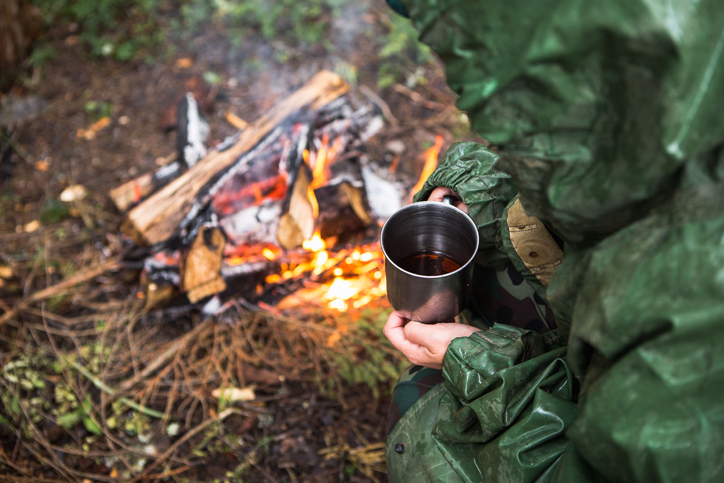
Somehow or other, it seems that we all get this idealistic vision of what a survival situation is going to be like. At least, everyone I talk to seems to do that.
The sun will be shining, the birds will be chirping, we’ll be camped by a babbling brook of clear, and cold mountain water and a nice big buck will walk right up to us and pose so that we can shoot it with our high quality bow and arrow, ensuring we have plenty to eat.
Reality is, of course, far from that. If there is one consistent I have found that we can count on in any survival situation, it’s bad weather. It is all but guaranteed that it will be cold, wet and if it’s not rainy, it will be because it is snowing… oh, and the wind will probably be blowing as well.
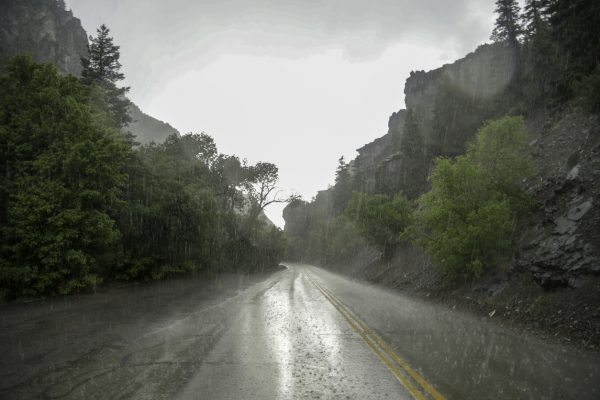
The one thing we will need the most in such a time is to start a fire. But have you ever tried starting a fire when it is cold, windy and wet? That’s enough to try the patience of Job, and I don’t have that much patience to work with. Starting a fire in such weather is a challenge, to say the least; but it’s a challenge we all need to be ready to overcome.
Be Prepared
The Boy Scouts have it right… be prepared. I don’t care what the situation is, you’re going to be better off if you’re prepared. In the case of starting a fire in wet weather, that means having a fire starting technique which you know that you can count on in that situation.
That’s really not the time you want to be trying to use a bow drill or Ferro Rod. You really don’t want to flick your Bic either, as those are notorious for blowing out with the slightest breeze.
My favorite fire starter is a stormproof lighter. This is a butane lighter with a piezoelectric igniter. What makes it stormproof is that as long as your thumb is holding down the gas valve, the igniter is going off. So if the wind and rain blow it out, it relights instantly. Being refillable, it’s good for thousands of lights.
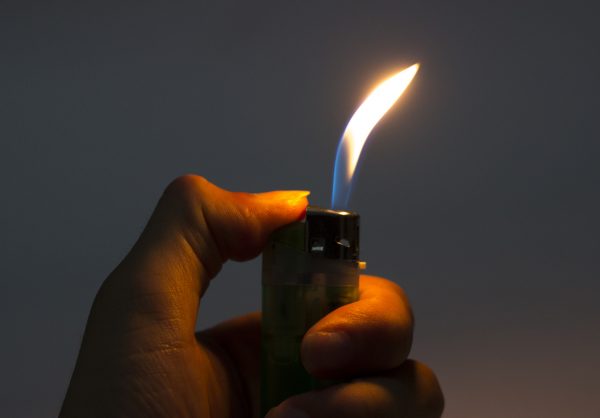
For a backup fire starter, I use stormproof matches. While these are also a bit pricey, they will literally light underwater and they can’t be blow out for a good three to four seconds. Kept in a waterproof match container, they will keep forever, until you need them.
An Accelerant Too
The other thing you need, to go with your fire starter, is a good accelerant. This is something to get the fire to spread quickly.
Arsonists commonly use gasoline in this way; although gasoline is far from the only accelerant there is. For a survival kit or bug out bag, you’re better off with a solid accelerant anyway, something like the WetFire cubes.
You can make your own accelerants out of petroleum jelly and cotton balls. Simply place a cotton ball into a bowl (preferably one your wife won’t mind you ruining) and work the petroleum jelly into it with the back side of a spoon.
You should be able to get a good teaspoon of petroleum jelly worked into a cotton ball. Store in an airtight container. These will burn for about three minutes and won’t blow out easily.

A more robust accelerant can be made of extra fine black powder and oily nail polish remover. Make sure you get the kind that contains acetone. Put a tablespoon of the black powder in a bowl and then cover it with the nail polish remover, leaving it there a few minutes to soak in.
Once the nail polish remover has soaked in, pour off the excess and start working the lump of softened black powder like putty. You want to knead it like a small lump of bread, folding it over at least 50 times.
This will create layers in the putty, which are important for controlling the burn rate. When finished, store in an airtight container. Only use if the putty is still damp. These will burn for about 3 ½ minutes at a temperature which is hot enough to dry out the fuel for your fire.
Finding Dry Fuel
It can be extremely difficult to find dry fuel for a fire, especially if it has been raining for any length of time. But there are always some places where there will be wood which has managed to stay dry. You just need to know where to look:
- Inside any convenient caves
- Under an overhang
- In the midst of a thicket
- The bottom branches of a large pine tree – These will die in place, once the sun can’t reach them. But they usually don’t fall off
- Dead branches on other trees, which haven’t fallen off
- The underside of an uprooted tree
- The bottom pieces of wood in a pile left by a previous camper
Location is Critical
To start a fire in these weather conditions, and even more importantly, to keep it burning, you have to pick the right location for the fire. Your fire is going to have to be protected from the wind and rain.
So it is going to have to have some sort of overhead cover, whether that is tree branches or an overhanging embankment. If you are building it under the trees, be sure that they are far enough above the fire that they won’t catch fire.
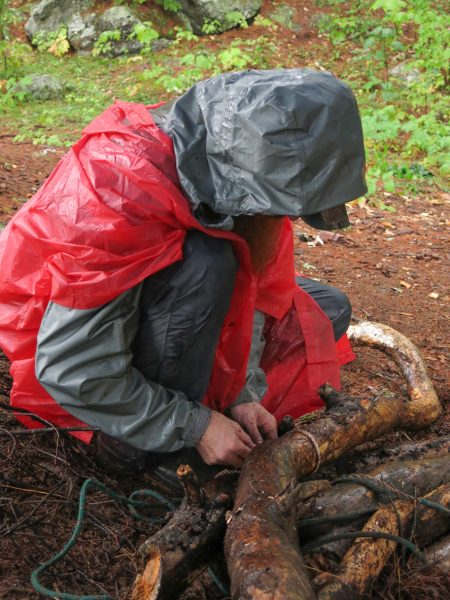
Protection from the wind can be hard to find. If you’re lucky, that overhanging embankment will be there and will be facing the right way so that you are in the lee side of it.
But if you don’t happen to have such an embankment, you’re probably going to have to make some sort of wind break. This can be a pile of stones or logs close to the fire. You can also use your shelter for this, with the back side of the shelter facing into the wind and the fire before the opening.
If there is a lot of rain, you’ll be better off if you can get your fire up off the ground by building a bed of rocks to lay it on. If there aren’t enough rocks, dig a trench around the fire pit, so that it can divert any running water from going into your fire.
Building the Fire
It is unlikely that you will be able to find any sort of dry tinder when it is wet outside, unless you can find a bird or squirrel nest in the bole of a tree. In ancient times, our ancestors carried a tinder box with them, so that they could gather tinder when they found it and always be sure of having it with them when they couldn’t.
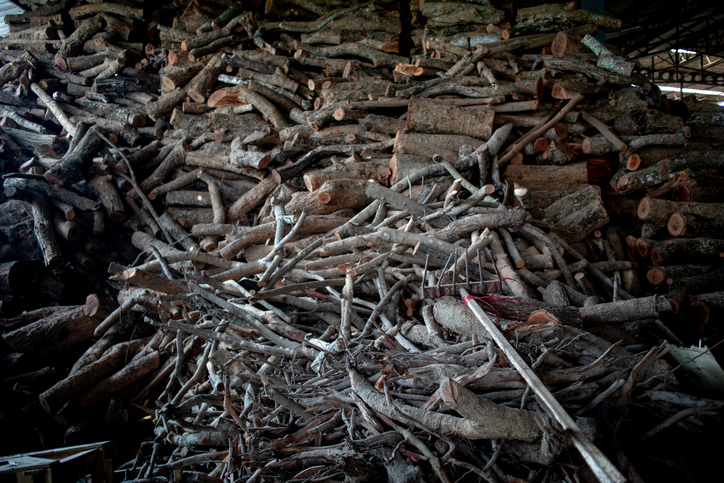
If you don’t have any tinder with you, fear not. The accelerants I was talking about earlier will perform the function of your tinder, eliminating the need for them.
You can also whittle a fuzz stick out of any convenient dry stick. That works well as a step to your kindling, as it will probably be made of the same sort of wood that your kindling is made of.
With the exception of using the accelerant, starting a fire in the rain is much like starting one any other time. Use the driest kindling and fuel you can find and stack additional fuel close to the fire, so the heat of the fire can dry it out and make it usable. If you can, rig some sort of shade over this supply of fuel, to help protect it from the rain.
